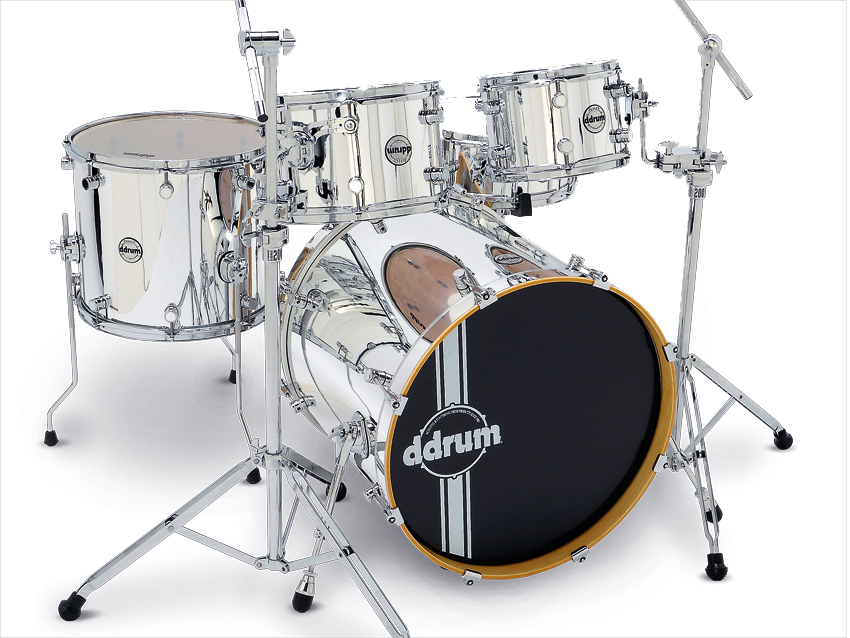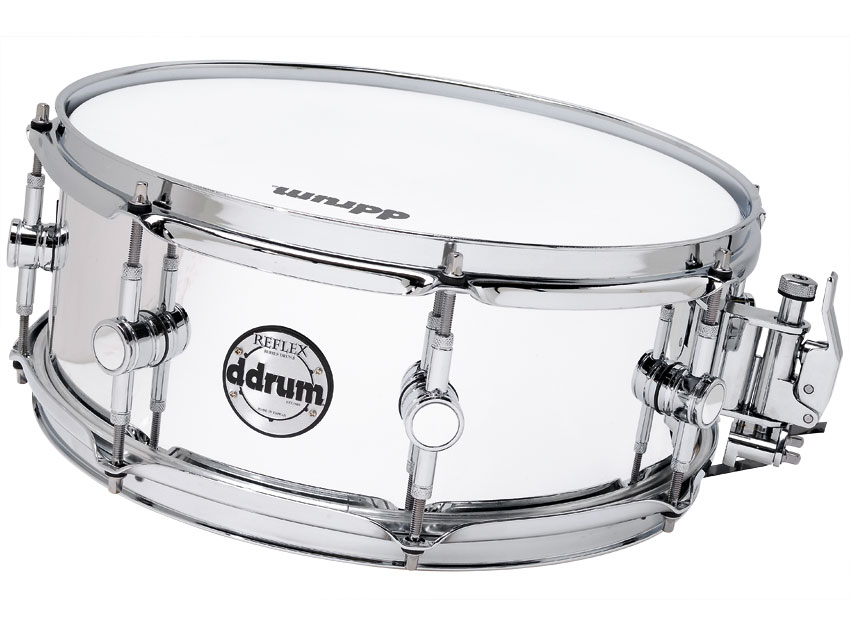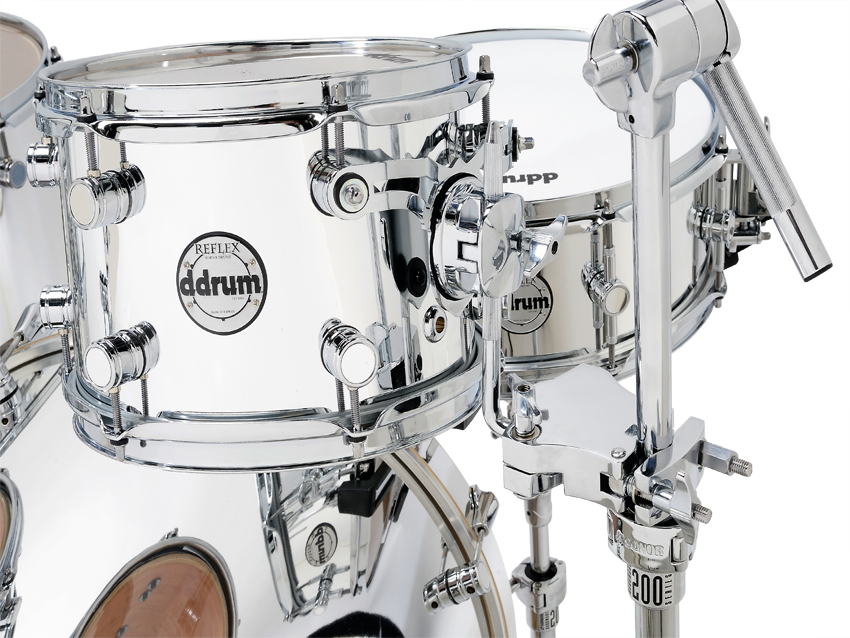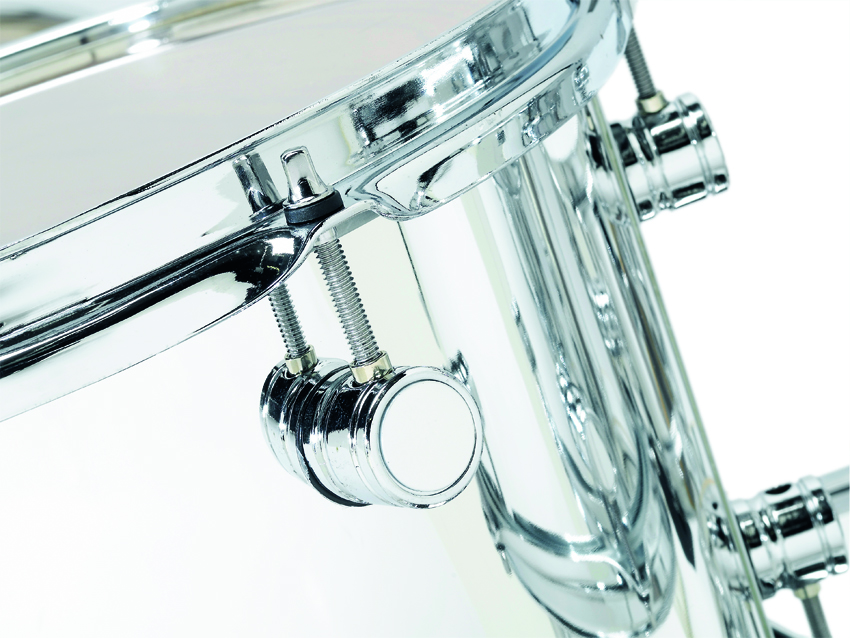MusicRadar Verdict
Heads issue aside, for what it is - a wrapped shellpack without stands - the kit seems expensive, particularly when compared to the non-Delmar finish options. At this price, the Delmar-wrapped Reflex is not just undercut by other brands, but bizarrely, by ddrum's own superior ranges.
Pros
- +
It's well made, looks stunning and sounds pretty good too. With different heads it has the potential to sound very good.
Cons
- -
However, a kit that costs the best part of a grand shouldn't require an immediate head change to get the best out of it.
MusicRadar's got your back

ddrum Reflex Kit

ddrum Reflex Snare

ddrum Reflex Toms
The mid-range Reflex kit is the latest addition to ddrum's roster. Made in Taiwan, Reflex drums take the place of the now discontinued Duo Fade range in ddrum's catalogue, although ddrum is keen to stress that it's a brand new product rather than a replacement series.
Build
After being launched at NAMM 2010, Reflex drum kits were initially rolled out in the USA before reaching the UK early this summer.
Two shellpack options are currently available: the five-piece Player kit on review, made up of a 22''x20'' bass drum, 14''x5.5'' snare, 10''x7" and 12"x8" toms and 16"x14" floor tom; and an alternative four-piece kit consisting of a 20"x20" kick, 13"x7" snare, 12"x8" tom and 16"x14" floor tom.
At the time of writing, supplies were still limited, to the extent that there were no examples of the four-piece shellpack in the country. Additional individual drums come in the shape of an 8" tom and 14" floor tom. ddrum devised a new shell for the Reflex Series, settling on alder after experimenting with a variety of woods.
A member of the birch family, alder is commonly used for smoking food. It has some history of musical applications, with the bodies of Fender Stratocaster and Telecasters - guitars renowned for their bright, sparkling tone - being made from alder. As a drum shell material, alder is reckoned to be fairly close to birch in character.
The shells are a mix of red alder and another, lighter-coloured alder with contrasting bands of colour marking out the different woods. Red alder is the inner ply on all of the drums and, as its name suggests, gives the shells a reddish tinge.
The ply count varies according to the relevant drum, with the bass drum and snare both having eight plies, while the toms and floor toms are six plies apiece. Bearing edges are cut at a fairly sharp 45 degrees, with a backcut intended to maximise head contact. The company's own Face-Off lugs are fitted to the kit.

An existing ddrum design, they have until now only appeared on ddrum Signature drums, most notably Vinnie Paul's limited edition kit. They are compact, turret-like structures that stand almost 3cm proud of the shell. Despite obvious low-mass qualities (they are only 25mm in diameter) the lugs are fixed to the shells with two small screws, which are located just inside the edge. This is because the centre of each lug houses a front-accessed thread that winds back into the body of the lug, towards the shell.
The thread is concealed by a removable metal disc (the Face in the lug's name). This type of lug design opens up a number of possibilities. On Vinnie Paul's kit for instance, metal spikes are screwed into the lugs and it's possible to customise the Reflex kit in this manner with accessories from ddrum, or indeed any object fitted with the corresponding male thread pattern. Other uses include the well-proportioned rubber bungs that are attached to the four bass drum lugs nearest the bottom of the shell, ensuring that any contact that the drum has with the ground is cushioned.
The Face-Off lugs are also used to incorporate ddrum's new Tuned Sustain tom suspension mounts. By attaching directly to a pair of lugs, the mounts make a discreet presence, both visually and practically (especially handy as this means that changing a head can be accomplished without removing the drum from its stand).
The standard of the rest of the shell hardware is uniformly high, with the tension rods running smoothly, while the 2.3mm hoops, bass drum spurs and claws and various clamps all exude solidity.
Reflex kits are available in a choice of four colours, all of which are wraps. The review kit that you can see here comes in a Delmar-made chrome wrap, which is super-shiny and seemingly impervious to scratching. Greasy finger marks show up fairly easily though, so regular buffing with a cloth might well be in order to keep it looking nice.
The most puzzling aspect of the Delmar wrap is the huge sum it adds to the cost of the kit, which makes the Chrome-wrapped Reflex more expensive than the equivalent all-maple, lacquer-finish ddrum Dominion Maple kit. In comparison, the three other wrap choices that come on the Reflex kit retail at between £200 and £300 less. we queried ddrum about these figures but was told that Delmar wraps simply cost more, which is something of an understatement…
Hands on
The combination of the shells and hardware gives the drums a substantial feel - none more so than the bass drum, with its 20" depth. This huge length, coupled with the fact that it is undrilled, makes it as deep and loud a drum as you could wish for. Such depth also induces a natural dampening as the heads are so far apart. Engaging the pedal results in a colossal wallop of low end that is free of any overtones or unwanted ringing. The birch-like qualities of alder are in evidence too, with the drum's note having a distinctive presence
We used the kit in an unmiked situation, where each touch of the bass drum swept aside any competing signals with almost casual force.
First impressions of the toms were of brightness and resonance. With both heads tuned to the same mid-range note they sang cleanly. Swapping the clear ddrum heads for branded single-ply coated versions calmed them a little, and gave them a more polished sound.Changing again for twin-ply batters increased the warmth and fatness further. The snare boasts high-end components in the form of a Dunnett snare release and butt end, yet surprisingly has only eight lugs.
It performed well, giving a sharp woody crack and rimshotting crisply.It's got a fair bit of grunt, and so is not really aimed at the quieter player. The level of sensitivity drops off in the last couple of centimetres into the edges. Here the snare wires still respond, but faintly, while the head sound remains at the same volume. It was least happy at the extremes of tunings, but in its preferred tuning range it delivered a more than acceptable performance.
“Excels at unique modulated timbres, atonal drones and microtonal sequences that reinvent themselves each time you dare to touch the synth”: Soma Laboratories Lyra-4 review
“I used everything I knew about music”: How Green Day exceeded expectations with their most ambitious song
YouTube just added AI tools that makes musicians, library music and video editors redundant









